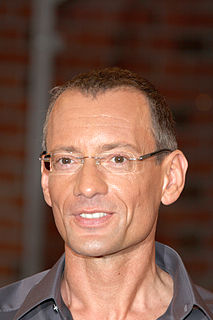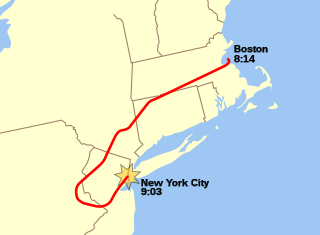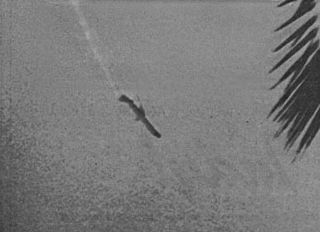Related Research Articles

Mathias Rust is a German aviator known for his illegal flight that ended with a landing near Red Square in Moscow on 28 May 1987. An amateur pilot, the then-teenager flew from Helsinki, Finland, to Moscow, being tracked several times by Soviet air defence and interceptor aircraft. The Soviet fighters did not receive permission to shoot him down, and his aeroplane was mistaken for a friendly aircraft several times. He landed on Bolshoy Moskvoretsky Bridge, next to Red Square near the Kremlin in the capital of the Soviet Union.
"Sinatra Doctrine" was the name that the Soviet government of Mikhail Gorbachev used jokingly to describe its policy of allowing neighboring Warsaw Pact states to determine their own internal affairs. The name alluded to the song "My Way" popularized by Frank Sinatra—the Soviet Union was allowing these states to go their own way. Its implementation was part of Gorbachev's doctrine of "new political thinking".

United Airlines Flight 175 was a scheduled domestic passenger flight from Logan International Airport, in Boston, Massachusetts, to Los Angeles International Airport, in Los Angeles, California. On September 11, 2001, the Boeing 767-200 operating the route was hijacked by five al-Qaeda terrorists and was deliberately crashed into the South Tower of the World Trade Center in New York City, killing all 65 people aboard and an unconfirmed number in the building's impact zone.

Erich Ernst Paul Honecker was a German politician who was the General Secretary of the Socialist Unity Party of Germany (SED) and the former leader of the DDR. As party leader he worked closely with Moscow. He controlled the government of the German Democratic Republic from 1971 until he was forced out in the weeks preceding the fall of the Berlin Wall in October 1989. From 1976 onward he was also the country's official head of state as Chairman of the State Council of the German Democratic Republic following Willi Stoph's relinquishment of the post.

Samantha Reed Smith was an American schoolgirl, peace activist, and child actress from Manchester, Maine, who became famous during the Cold War between the United States and the Soviet Union. In 1982, Smith wrote a letter to the newly appointed CPSU General Secretary Yuri Andropov, and received a personal reply with a personal invitation to visit the Soviet Union, which she accepted.

Viktor Ivanovich Belenko is an American aerospace engineer and former Soviet pilot who defected to the West while flying his MiG-25 jet fighter and landed in Hakodate, Japan. George H. W. Bush, the Director of Central Intelligence at the time, called the opportunity to examine the plane up close an "intelligence bonanza" for the West. Belenko later became a U.S. aerospace engineer.

Alexander Nikolaevich Yakovlev was a Soviet and Russian politician and historian. During the 1980s he was a member of the Politburo and Secretariat of the Communist Party of the Soviet Union. He was called the "godfather of glasnost" as he is considered to be the intellectual force behind Mikhail Gorbachev's reform program of glasnost and perestroika.

Aeroméxico Flight 498 was a scheduled commercial flight from Mexico City, Mexico, to Los Angeles, California, United States, with several intermediate stops. On Sunday, August 31, 1986, the McDonnell Douglas DC-9 operating the flight was clipped in the tail section by N4891F, a Piper PA-28-181 Archer owned by the Kramer family, and crashed into the Los Angeles suburb of Cerritos, killing all 67 on both aircraft and an additional fifteen on the ground. Eight on the ground also sustained minor injuries from the midday crash.

Operation Yellow Ribbon was commenced by Canada to handle the diversion of civilian airline flights in response to the September 11 attacks in 2001 on the United States. Canada's goal was to ensure that potentially destructive air traffic be removed from United States airspace as quickly as possible, and away from potential U.S. targets, and instead place these aircraft on the ground in Canada, at military and civilian airports primarily in the Canadian provinces of Nova Scotia, Newfoundland and Labrador, and British Columbia. Yukon, New Brunswick, Alberta, Manitoba, Ontario, Northwest Territories, and Quebec also took in aircraft so that any malicious or destructive potential could be better contained and neutralized. None of the aircraft proved to be a threat, and Canada hosted thousands of passengers who were stranded until U.S. airspace was reopened.

The 1988 Armenian earthquake, also known as the Spitak earthquake, occurred on December 7 at 11:41 local time with a surface wave magnitude of 6.8 and a maximum MSK intensity of X (Devastating). The shock occurred in the northern region of Armenia which is vulnerable to large and destructive earthquakes and is part of a larger active seismic belt that stretches from the Alps to the Himalayas. Activity in the area is associated with tectonic plate boundary interaction and the source of the event was slip on a thrust fault just to the north of Spitak. The complex incident ruptured multiple faults, with a strike-slip event occurring shortly after the initiation of the mainshock. Between 25,000 and 50,000 were killed and up to 130,000 were injured.

Eddie August Henry Schneider was an American aviator who set three transcontinental airspeed records for pilots under the age of twenty-one in 1930. His plane was a Cessna Model AW with a Warner-Scarab engine, one of only 48 built, that he called "The Kangaroo". He set the east-to-west, then the west-to-east, and the combined round trip record. He was the youngest certificated pilot in the United States, and the youngest certified airplane mechanic. He was a pilot in the Spanish Civil War in the Yankee Squadron. He died in an airplane crash in 1940, while training another pilot, when a Boeing-Stearman Model 75 belonging to the United States Navy Reserve overtook him and clipped his plane's tail at Floyd Bennett Field.

The Friendship Games, or Friendship-84, was an international multi-sport event held between 2 July and 16 September 1984 in the Soviet Union and eight other socialist states which boycotted the 1984 Summer Olympics in Los Angeles.

Fay Gillis Wells was an American pioneer aviator, globe-trotting journalist and a broadcaster.

Bar Harbor Airlines Flight 1808 was a scheduled flight from Logan International Airport to Bangor International Airport in the United States on August 25, 1985. On final approach to Auburn/Lewiston Municipal Airport, the Bar Harbor Airlines Beechcraft Model 99 crashed short of the runway, killing all six passengers and two crew on board. Among the passengers was Samantha Smith, a thirteen-year-old American schoolgirl who had become famous as a "Goodwill ambassador" to the Soviet Union and who had been cast on the television show Lime Street.
During the 20th century a number of peace walks were organized involving the citizens of the United States and the USSR. These peace walks, or peace marches, represented citizen diplomacy initiatives promoting peace and Nuclear disarmament through direct person-to-person interaction among the citizens of the two Cold War opponent states.

Flight is a 2012 American drama film directed by Robert Zemeckis, written by John Gatins and produced by Walter F. Parkes, Laurie MacDonald, Steve Starkley, Zemeckis and Jack Rapke. It stars Denzel Washington as William "Whip" Whitaker Sr., an alcoholic airline pilot who miraculously crash-lands his plane after a mechanical failure, saving nearly everyone on board. Immediately following the crash, he is hailed a hero but an investigation soon leads to questions that put the captain in a different light. This film is loosely inspired by the plane crash of Alaska Airlines Flight 261.

The Chicken Kiev speech is the nickname for a speech given by the United States president George H. W. Bush in Kyiv (Kiev), Ukraine, on August 1, 1991, 3 weeks before the Declaration of Independence of Ukraine and 4 months before the December independence referendum in which 92.26% Ukrainians voted to withdraw from the Soviet Union, in which Bush cautioned against "suicidal nationalism". 145 days after the speech, the Soviet Union collapsed, partially pushed by Ukraine. The speech was written by Condoleezza Rice—later Secretary of State under President George W. Bush—when she was in charge of Soviet and Eastern European affairs for the first President Bush. It outraged Ukrainian nationalists and American conservatives, with the conservative New York Times columnist William Safire calling it the "Chicken Kiev speech" in protest at what he saw as its "colossal misjudgment" for the very weak tone and miscalculation.
Aleksandr Vladimirovich Vlasov was a Soviet politician, who held different positions, including interior minister and prime minister. He was the last communist prime minister of Russia, and a close ally of Mikhail Gorbachev.

Aeroflot Flight 6502 was a Soviet domestic passenger flight operated by a Tupolev Tu-134A from Sverdlovsk to Grozny, which crashed on 20 October 1986. 70 of the 94 passengers and crew on board were killed. Investigators determined the cause of the accident to be pilot negligence.
The foreign policy of the George H. W. Bush administration was the foreign policy of the United States from January 1989 to January 1993 while George H. W. Bush was the Republican president. He had very extensive foreign policy experience, but unlike Ronald Reagan he downplayed vision and emphasized caution and careful management. His main foreign policy advisors were Secretaries of State James Baker and Lawrence Eagleburger, and National Security Advisor Brent Scowcroft. Momentous geopolitical events that occurred during Bush's presidency include:
References
- ↑ "Pilot, 11, Begins Trip Around Globe". Los Angeles Times. 5 June 1989.
- ↑ "Aviator, 11, Starts Flight To U.S.S.R." The New York Times. 6 June 1989.
- ↑ "Soviets Greet U.S. Pilot, 11, With Open Arms". Deseret News. 24 June 1989.
- ↑ "Tony Circles the Globe: Tony Meets Soviet Press, Pronounces Flying 'Basically Boring". Los Angeles Times. 28 June 1989.
- ↑ "Tony Circles the Globe: For Boy Pilot, Family It's a Red-Letter Day in Red Square". Los Angeles Times. 29 June 1989.
- ↑ "Friendship Flight Includes Stop in S.L." Deseret News. 6 June 1989.
- ↑ "Tony Circles the Globe: Orange County Boy Takes Off on Odyssey". Los Angeles Times. 6 June 1989.
- ↑ "Children Greet Tony in Leningrad: 'Friendship Flier,' 11, Welcomed With Salt, Bread, Flowers, Poem". Los Angeles Times. 23 June 1989.
- ↑ "Boy Pilot Flies Into the 'Land of the Soviets'". Los Angeles Times. 24 June 1989.
- ↑ "Stories on Flight of Tony Aliengena". Los Angeles Times. 16 July 1989.